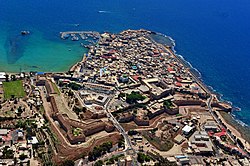
Back Akko Afrikaans Akkon ALS عكا Arabic عكا ARZ Acre (ciudá) AST Əkka Azerbaijani عکا AZB Ака (горад) Byelorussian Акра (Израел) Bulgarian Akko Breton
Acre
| |
|---|---|
| Hebrew transcription(s) | |
| • ISO 259 | ʕAkko |
 | |
| Coordinates: 32°55′40″N 35°04′54″E / 32.92778°N 35.08167°E | |
| Grid position | 156/258 PAL |
| Country | Israel |
| District | Northern |
| Founded | 3000 BC (Bronze Age settlement) 1550 BC (Canaanite settlement) 1104 (Crusader rule) 1291 (Mamluk rule) 1948 (Israeli city) |
| Government | |
| • Mayor | Amihai Ben Shlush (since 2024)[1] |
| Area | |
| • Total | 13,533 dunams (13.533 km2 or 5.225 sq mi) |
| Population (2022)[2] | |
| • Total | 51,420 |
| • Density | 3,800/km2 (9,800/sq mi) |
| Official name | Old City of Acre |
| Criteria | Cultural: ii, iii, v |
| Reference | 1042 |
| Inscription | 2001 (25th Session) |
| Area | 63.3 ha |
| Buffer zone | 22.99 ha |
Acre (/ˈɑːkər, ˈeɪkər/ AH-kər, AY-kər), known locally as Akko (Hebrew: עַכּוֹ, ʻAkkō) and Akka (Arabic: عكّا, ʻAkkā), is a city in the coastal plain region of the Northern District of Israel.
The city occupies a strategic location, sitting in a natural harbour at the extremity of Haifa Bay on the coast of the Mediterranean's Levantine Sea.[3] Aside from coastal trading, it was an important waypoint on the region's coastal road and the road cutting inland along the Jezreel Valley. The first settlement during the Early Bronze Age was abandoned after a few centuries but a large town was established during the Middle Bronze Age.[4] Continuously inhabited since then, it is among the oldest continuously inhabited settlements on Earth.[5] It has, however, been subject to conquest and destruction several times and survived as little more than a large village for centuries at a time.
Acre was a hugely important city during the Crusades as a maritime foothold on the Mediterranean coast of the southern Levant and was the site of several battles, including the 1189–1191 Siege of Acre and 1291 Siege of Acre. It was the last stronghold of the Crusaders in the Holy Land prior to that final battle in 1291. At the end of Crusader rule, the city was destroyed by the Mamluks, thereafter existing as a modest fishing village until the rule of Zahir al-Umar in the 18th century.[6]
In 1947, Acre formed part of Mandatory Palestine and had a population of 13,560, of whom 10,930 were Muslim and 2,490 were Christian. As a result of the United Nations Partition Plan for Palestine and subsequent 1948 Arab-Israeli war, the population of the town dramatically changed as its Palestinian-Arab population was expelled or forced to flee; it was then resettled by Jewish immigrants.[7] In present-day Israel, the population was 51,420 in 2022,[2] made up of Jews, Muslims, Christians, Druze, and Baháʼís.[8] In particular, Acre is the holiest city of the Baháʼí Faith in Israel and receives many pilgrims of that faith every year. Acre is one of Israel's mixed cities; 32% of the city's population is Arab. The mayor is Shimon Lankri, who was re-elected in 2018 with 85% of the vote.
- ^ "תוצאות הבחירות המקומיות 2024". www.themarker.com (in Hebrew). March 3, 2024. Retrieved 2024-05-07.
- ^ a b "Regional Statistics". Israel Central Bureau of Statistics. Retrieved 21 March 2024.
- ^ "Old City of Acre." Archived 2020-10-24 at the Wayback Machine, UNESCO World Heritage Center. World Heritage Convention. Web. 15 April 2013
- ^ Cite error: The named reference
NegevGibsonwas invoked but never defined (see the help page). - ^ Petersen, 2001, p. 68 Archived 2019-03-24 at the Wayback Machine
- ^ Greene, Roberta R.; Hantman, Shira; Seltenreich, Yair; ʻAbbāsī, Muṣṭafá (2018). Living in Mandatory Palestine: personal narratives of resilience of the Galilee during the Mandate period 1918-1948. New York, NY: Routledge. p. 10. ISBN 978-1-138-06898-8.
Acre, too, enjoyed a revival under Daher's rule. The historic port city, which was destroyed by the Mamelukes at the end of the Crusades in the late thirteenth century, was only a small fishing village before Daher arrived. The ambitious ruler, aware of the importance of the port for strengthening his commercial ties with Europe, decided to rebuild it, and it is almost certain that in 1746 he also moved his government center there. He surrounded it with a wall and built a khan, a mosque, a fortress, and the other symbols of authority in the city. Daher's Acre became one of the country's major cities, along with Jerusalem, Nablus, and Jaffa.
- ^ Abbasi, Mustafa (2010). "The Fall of Acre in the 1948 Palestine War". Journal of Palestine Studies. 39 (4): 6–27. doi:10.1525/jps.2010.xxxix.4.6. ISSN 0377-919X. JSTOR 10.1525/jps.2010.xxxix.4.6.
- ^ "History & Overview of Acre". www.jewishvirtuallibrary.org. Archived from the original on 2017-07-10. Retrieved 2021-02-28.
© MMXXIII Rich X Search. We shall prevail. All rights reserved. Rich X Search


